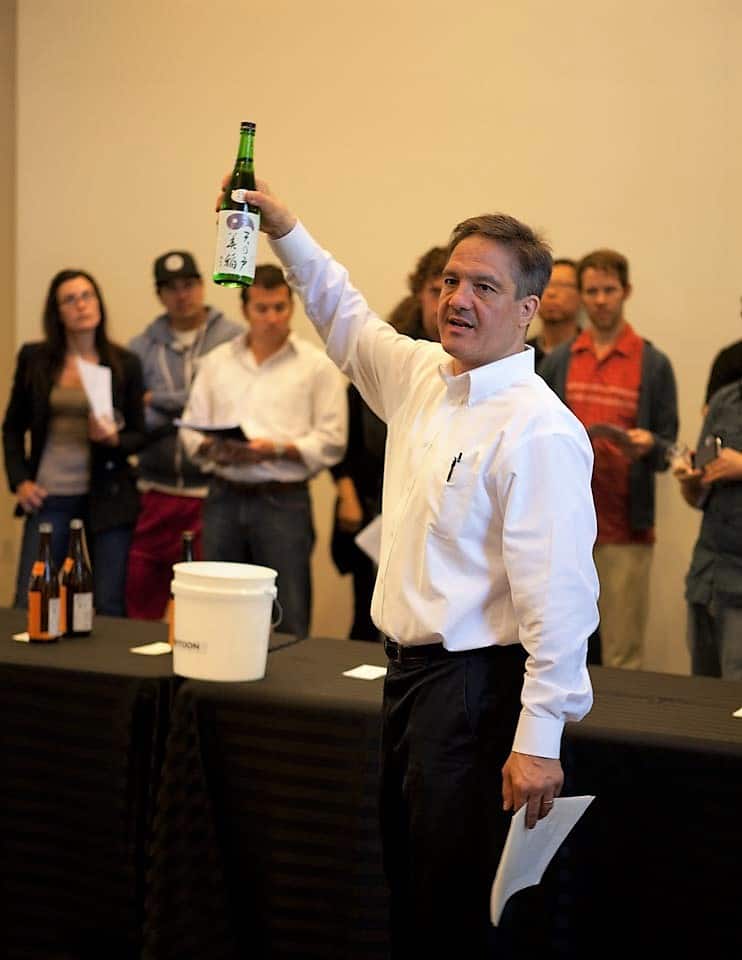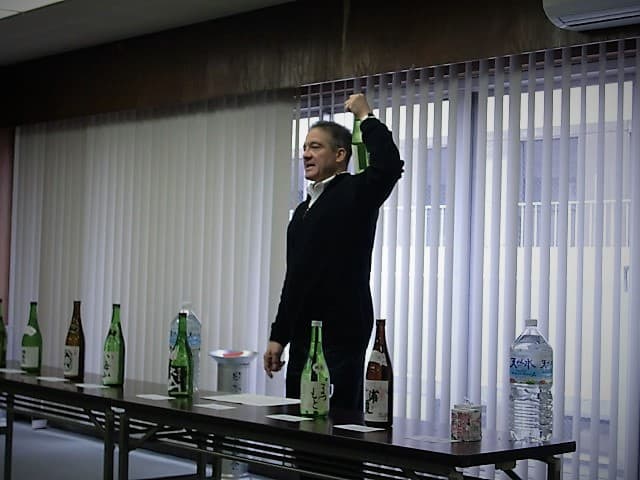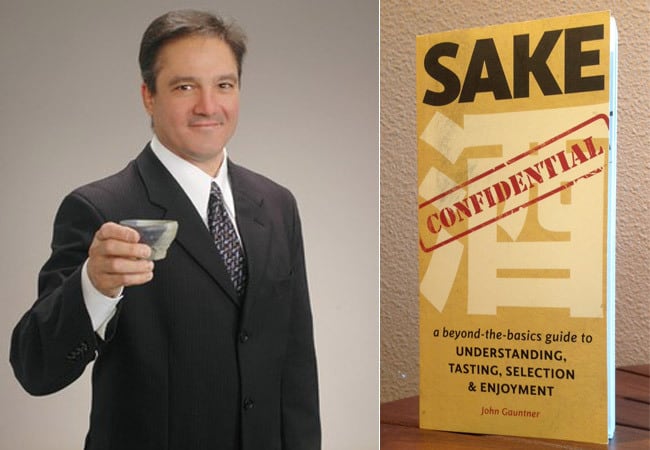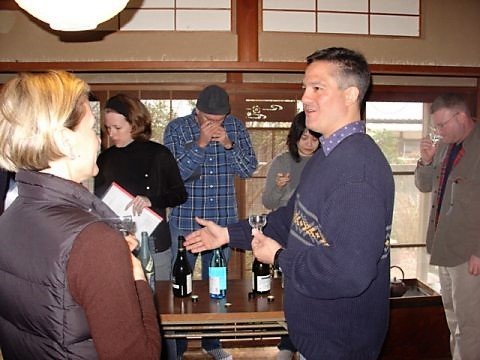Se si parla di sake, John Gauntner è una celebrità del settore. Abbiamo avuto modo di scambiarci due parole, e questo è quello che ci ha raccontato.
For the original English version of this interview, please click here.
il Sake: Ciao John, cominciamo. Per quelli che non ti conoscono, potremmo definirti una “cintura nera” del sake, un uomo il cui curriculum sarebbe eccezionale anche per un giapponese e il primo e solo gaijin a ottenere entrambe le certificazioni di Sake Expert Assessor e Master of Sake Tasting. Ma come è iniziata la tua relazione col sake?
John Gauntner: È iniziato in maniera piuttosto semplice. Sono arrivato in Giappone il primo agosto del 1988 e a capodanno del 1989 sono stato invitato a casa di un collega, che mi ha fatto conoscere il sake, quello buono. Non avrei però mai pensato che quello sarebbe diventato il mio lavoro. Poi ho incontrato un tizio a una festa che lavorava per il Japan Times e, dopo aver parlato un po’ di sake, mi ha chiesto se avessi voluto scrivere un articolo per loro. Da qui è nata una rubrica, poi dei libri, poi altro studio ancora e, di conseguenza, altro lavoro nell’industria del sake. Tutto è nato così.

iS: Sei conosciuto come “The sake guy” e “The sake evangelist”, per via del tuo lavoro di diffusione della conoscenza del sake dentro e fuori il Giappone, con pubblicazioni, libri, corsi e seminari. In tutti questi anni di attività, quali sono i principali pregiudizi nelle persone prima del loro primo approccio al sake?
JG: Bella domanda! Uno: essendo prodotto a partire da semplici chicchi di riso e non dall’uva, non sarà mai sofisticato, complesso, godibile, interessante o variegato come un vino. Due: che debba sempre essere servito caldo. Tre: che si sposa bene solo col cibo giapponese. Quattro: che è un distillato o è pungente. Ce ne sarebbero altri, ma questi sono i principali.
iS: Come immagino tu sappia, qui in Italia siamo molto fieri dei nostri prodotti e del nostro cibo. È difficile pensare a un pasto senza il vino, quindi è ancora più difficile concepire un pasto abbinandoci del sake. Quali sake ci consiglieresti di bere, per sfidare la nostra riluttanza ai cambiamenti?
JG: Un’altra bella domanda. Penso che sia meglio iniziare con un junmai dalla marcata acidità, così che si stabilisca una presenza della parte del sake che ben si abbina a pietanze con olio o grasse. Poi, in un primo momento, un sake stile yamahai o kimoto, con note più marcate di selvaggina e umami, che anche queste si sposano bene con una gran quantità di cibo. Un ginjo più leggero potrebbe sostituire il vino bianco come semplice abbinamento che va giù bene senza troppi problemi o pensieri.
Questi sono i tre con in quali partirei, e credo che da lì in poi le cose seguiranno naturalmente, sempre che i commensali siano interessati a provare!
iS: Com’è la situazione del sake in Giappone? La qualità negli ultimi decenni è aumentata sensibilmente ma, correggimi se sbaglio, ora è la birra l’alcolico più venduto nel paese. Le nuove generazioni ignorano il sake?
JG: Hai ragione riguardo la birra, e infatti il sake è sceso al 6% (!) del totale di alcol consumato! Quindi dipende da come la vuoi vedere. Il 65% del mercato del sake è composto da honjozo e futsuushu, e anche questi sono in calo quindi, se i due terzi del tuo mercato sono in contrazione, tutto il mercato lo è. Per la buona notizia è che i junmai e i quattro tipi di ginjo stanno stabilmente crescendo, di una media forse del 10% annuo. Quindi sì, il mercato è in contrazione, ma sta venendo sostituito dal sake premium, che è sicuramente positivo. E le nuove generazioni sono in prima fila in questo cambiamento, quindi non direi che lo stiano ignorando anzi, lo stanno salvando!
iS: Fuori dai confini giapponesi, invece, ci sono parecchie nazioni che sono entrate in contatto col sake negli anni passati, sicuramente di più di quanto fatto da noi in Italia. Quali sono le nazioni che, secondo te, hanno dato un contributo rilevante all’industria del sake (se ce ne sono)? Qualche prodotto degno di nota?
JG: Sicuramente gli Stati Uniti. Sono americano, quindi potrei essere di parte, ma gli USA importano più sake di chiunque altro, e questo già da tempo. Gli Stati Uniti non hanno una lunga tradizione per quanto riguarda i vini (o qualsiasi altra cosa) come l’Europa, quindi culturalmente sono più aperti a provare tutto, ed è questo uno dei motivi per cui il sake è letteralmente decollato. Inoltre, considera anche che la popolarità del cibo giapponese negli USA (e ovunque) ha giocato un grosso ruolo. Anche Hong Kong è stato un gran promotore e consumatore di sake giapponese. Il Regno Unito ha lavorato molto nella promozione del sake, ma lì i numeri sono ancora bassi.
Ad ogni modo, nei prossimi anni tutti quelli di settore si aspettano una grande crescita per quanto riguarda l’Europa.

iS: Il vino e il sake hanno punti di contatto per quanto riguarda il metodo di produzione, ma a parte quello sono prodotti molto diversi. Quindi penso che assaggiarli e farlo in maniera professionale richieda capacità diverse a seconda della bevanda. Cosa puoi dirci a riguardo della differenza nell’assaggiare un vino e un sake come un sommelier professionista?
JG: A dire il vero, io credo che alla fine siano molto simili, molto più di quanto non pensi la gente. Un palato allenato ed educato è un palato alleato ed educato. Sicuramente c’è bisogno di qualche adeguamento, per quanto riguarda il riconoscere anche pregi e difetti. Ma una persona che è capace di assaggiare il vino riuscirà in poco tempo a valutare anche il sake. Il sake è solitamente meno appariscente, ma è così che deve essere. Il cibo giapponese e quello occidentale sono un bel parallelo di ciò.
Per fare un esempio, molti sommelier di vino vedono come positivo un’aroma molto fruttato quando invece, da un punto di vista strettamente tradizionale, non lo è. Molti altri avvertono dell’ossidazione nei sake leggermente invecchiati, quando invece si tratta di aminoacidi e zuccheri che hanno creato un legame. E molto spesso pensano “sappia di tappo”, cioè pensano di sentire il TCA (tricloroanisolo, la sostanza che conferisce il sentore di tappo) e, nonostante non sia impossibile avvertire il TCA, spesso sentono qualcos’altro. E questo “qualcos’altro”, anche fosse una nuance di muffa, non è necessariamente un difetto. Anzi, è molto interessante.
Quindi i metodi d’assaggio sono praticamente i soliti, ma per valutare cosa è buono e cosa non lo è serve un po’ di tempo.
iS: Ultima, promesso! Secondo me provare (in questo caso assaggiare) è la prima strada verso la conoscenza ma se qualcuno volesse leggere un libro sul sake, quale consiglieresti?
JG: Ritengo che ormai tutte le informazioni di base sul sake siano già su internet quindi penso che la gente possa scremarle e fare un passo avanti. Per quello, consiglio il mio libro, “Sake Confidential”. Ad ogni modo, il libro di Philip Harper “The Book of Sake: A Connoisseur’s Guide” è eccellente, oltre che scritto da qualcuno che è realmente un maestro produttore. Caldamente consigliato. (Nota: entrambi solo in lingua inglese)

Puoi seguire gli aggiornamenti di John su Facebook (https://www.facebook.com/johngauntner), Twitter (https://twitter.com/JohnGauntner), Instagram (https://www.instagram.com/johngauntner/) oppure sul suo sito, Sake-world, una risorsa immancabile tra i preferiti di chi ama il sake.
English version
il Sake: For those who don’t know you, I can say you are a “black belt” of sake, a man whose curriculum would be exceptional also for a Japanese, and the first and only gaijin who obtained both the certifications as Sake Expert Assessor and Master of Sake Tasting. But how and when your relationship with sake started?
John Gauntner: I got started in a fairly simple way. I arrived in Japan on August 1, 1988, and on January 1, 1989, I was invited to a co-worker’s house that introduced me to good sake. I never thought I would make it my work, though. But I met a guy at a party that worked for the Japan Times, and after talking about sake, he asked me to write an article for them. This led to a column, which led to books, which led to more study, which led to more work in the industry. And it just grew from there.
iS: You are known as “The sake guy” and “The sake evangelist”, due to your work in spreading the knowledge of sake in and out Japan, with publications, books, study courses and seminars. In all those years and activities, which are the main prejudices you find in people before they approach sake for the first time?
JG: Great question! One is that, since it made from a mere grain, and not grapes, it could not ever be as sophisticated, complex, enjoyable, interesting or diverse as wine. Two that all of it should be served hot. Three that it only goes with Japanese food. Four, that it is distilled or harsh. There are more but those are the main ones.
iS: As I guess you know, here in Italy we are very proud of our products and food. It’s difficult to have a meal with no wine, so it’s even more difficult to think about eating with sake instead. What sakes would you propose to drink, to challenge our reluctance to changes?
John Gauntner: Another great question. I think the best to start out with are junmai with a prominent acidity, since that establishes a presence on the part of the sake that can be used to pair with a component such as oiliness or fat. Next, at first anyway, yamahai and kimto styles have more gaminess and umami that can be used to pair well with a wide range of food too. Lighter ginjo might replace white wine as a simple pairing that goes down easily without a whole lot of fuss or thinking.
Those are the three I would start with, and I think things will flow naturally from there, assuming that the folks involved are actually interested in trying!
iS: How’s the situation of sake in Japan? The quality in the last decades improved considerably but, correct me if I’m wrong, now beer is the most sold alcoholic beverage in the country. Are the new generations ignoring sake?
John Gauntner: You are right about beer, and in fact, sake has dropped to six percent (!) of all alcohol consumed! So it depends on how you look at it. 65% of the sake market is honjozo and futsuushu, and those are dropping, so if two-thirds of your market is contracting, the whole market will do so. But the good news is that junmai and the four ginjo types are growing steadily, perhaps an average of 10 percent a year. So the market is contracting but shifting quickly to premium, which is a good thing. And it is the new generation that is leading that. So the new generation is not ignoring sake, they are sake’s savior!

iS: Outside of Japan, instead, there are many countries that became familiar with sake in the past years for sure more than we did here in Italy. Which are the countries that, in your opinion, gave a relevant contribution to sake industry (if any)? Any product you’d like to mention?
JG: Certainly the US. I am American, so I might be biased, but the US imports more sake than anywhere, and has for a while. The US does not have a long, long tradition of wine (or anything else) like Europe, so the culture is pretty much open to trying anything, and that is partly what made sake take off so well. But also, note that the popularity of Japanese food in the US (and elsewhere) played a huge role too. Hong Kong has been a big promoter and consumer of sake from Japan as well. The UK has done a lot of work promoting sake, but still, actual numbers are low.
However, everyone in the industry expects lots of growth from Europe over the next few years.
iS: Wine and sake have a bit in common when we speak about the production methods, but other than that they’re two very different products. So I guess that tasting and be a professional about it, requires different skills depending on the beverage. What can you tell us about the difference between tasting wine and tasting sake like a professional sommelier?
JG: Actually, I think they are very similar in the end, much more so than most people. A trained and educated palate is a trained and educated palate. Surely some adjustments are needed, in terms of recognizing faults and positive points too. But one that can taste wine will come up to speed very quickly in assessing sake. Sake is less ostentatious, usually, but it is supposed to be so. Japanese food and western food are a nice parallel to this.
As an example, a lot of wine soms might see huge fruity aromas in sake as a positive, when in fact, from a traditional viewpoint they are not so. Also, many wine tasters see oxidation in slightly mature sake, when it is not oxidation but rather amino acids and sugars that have bonded. And very often wine people think a sake is corked, i.e. they think they smell TCA, and while it is not impossible to have TCA very often they see something else. And that something else – even if it is a slightly moldy nuance – is not necessarily a fault. It is very interesting, actually.
So the tasting methods are pretty much the same, but assessing what is good and what is bad takes a little bit of time.
iS: Last one, I promise! In my opinion, trying (in this case tasting) it’s the first way to the knowledge but if someone would like to read a book about sake, which one would you recommend?
JG: I think that much information about sake basics is on the internet already, so I think that folks can skim that and go a step beyond. For that, I can recommend my own book, Sake Confidential. However, Philip Harper’s book “The Book of Sake: A Connoisseur’s Guide” is excellent, and written by someone that is an actual master brewer. Highly recommended.
You can follow John’s updates on Facebook (https://www.facebook.com/johngauntner), Twitter (https://twitter.com/JohnGauntner), Instagram (https://www.instagram.com/johngauntner/) or on his site, Sake-world, a must-read resource for all the sake lovers.

